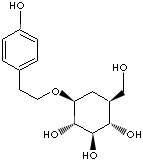SALIDROSIDE
PRODUCT IDENTIFICATION
10338-51-9

H.S. CODE
TOXICITY
CLASSIFICATION
PHYSICAL AND CHEMICAL PROPERTIES
AUTOIGNITION
NFPA RATINGS
REFRACTIVE INDEX
Stable under ordinary conditions
EXTERNAL LINKS & GENERAL DESCRIPTION
A range of antioxidant compounds have been identified in Rhodiola rosea and related species, including p-tyrosol, organic acids (gallic acid, caffeic acid, and chlorogenic acid), and flavonoids (catechins and proanthocyanidins). Significant free-radical scavenging activity has been demonstrated for alcohol and water extracts of Rhodiola sp. and is attributed to the variety of antioxidant compounds. p-Tyrosol has been shown to be readily and dose-dependently absorbed after an oral dose, and appears to produce a significant antioxidant8 and modest 5-lipoxygenase inhibitory activity in vivo. Salidroside (rhodioloside), the additional salidroside-like glycoside compounds (rhodiolin, rosin, rosavin, rosarin, and rosiridin), and p-tyrosol are thought to be the most critical plant constituents needed for therapeutic activity. (http://www.thorne.com/)
It became evident that salidroside is present in all chemically analyzed plants in the genus Rhodiola, and in a wide variety of species outside the genus. The term salidroside is derived from Salix, the genus name for the willows. Salidroside was first isolated in 1926 from Salix triandra L. (Salicaceae). Since then it has been detected in Vaccinium vitis-idaea L. (Ericaceae) and in Rhododendron (plants not belonging to the genus Rhodiola) in concentrations that can be higher than levels found in Rhodiola species, including R. rosea. Therefore, salidroside alone is not a useful marker compound for differentiating true R. rosea from other Rhodiola species; nor should it be used as the only marker compound for the standardization of R. rosea root extracts. According to the revised 1989 Soviet Pharmacopeia, the extracts of R. rosea - primarily in the form of water/alcohol tinctures or dried root extract - are now standardized for both rosavins and salidroside. Although rosavins are now the accepted marker for genetically pure R. rosea (and its extracts), they are not necessarily the only pharmacologically active ingredients responsible for the efficacy observed in clinical studies. In fact, precise identification of the compounds responsible for the numerous health benefits of R. rosea remains to be confirmed. R. rosea extracts used in most human clinical studies were standardized to minimum 3 percent rosavins and 0.8-1 percent salidroside because the naturally occurring ratio of these compounds in R. rosea root is approximately 3:1. (https://www.medicine-plants.com/)Bioactive Constituents of Rhodiola rosea extracts
- Flavonoids - Rodiolin, Rodionin, Rodiosin, Acetylrodalgin, Tricin, Catechins And Proanthocyanidins
- Monoterpenes - Rosiridol, Rosaridin, Rhodiolin
- Phenolic Acids - Chlorogenic, Hydroxycinnamic, Gallic Acids, Caffeic Acids
- Phenylethanol Derivatives - Salidroside, Tyrosols
- Phenylpropanoids - Rosavin, Rosin, Rosarin
- Triterpenes - Daucosterol, Beta-sitosterol
APPEARANCE
ASSAY
PRICE
U$2,500 (20g)